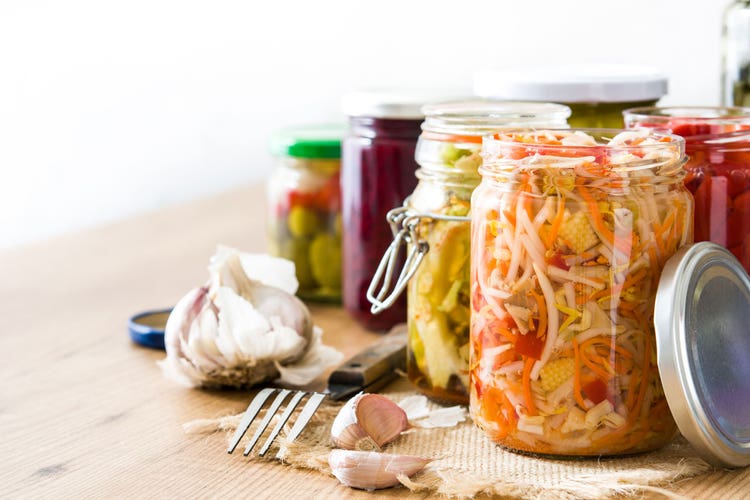Grow Your Own Biome

Good health is something that doesn’t always come naturally, and sometimes we have to take steps toward it that also have not-so-desirable effects. Now that it’s flu season, there may be times when a secondary infection necessitates stronger help than a bowl of chicken soup. Antibiotics can stop the infection, but they can do so at the expense of the microbiome in our gut, which we now know is just as important as a line of defense against illness.
I travel a lot, so I decided to try building up my own microbiome before it’s put to the test by a cold or flu bug.
Fermenting knowledge

I have to admit that the popularity of fermented foods had escaped me until now. I ate yogurt because I knew it was healthy, but I hadn’t explored what other sources of probiotics there are. So when I decided to give my system a little extra help, I learned about foods loaded with good bacteria, such as kefir, kombucha, miso and raw apple cider vinegar, all of which begin with mold or bacteria. As unappetizing as it sounds (and it can be an acquired taste), remember that making cheese also requires mold, and just about everyone can find something to like about cheese.
I also found out that I had a few misconceptions about other fermented foods, namely yogurt, miso and sauerkraut. Most yogurt contains live strains of bacteria, but you do need to check the label to be sure. And not just any jar of sauerkraut or instant miso soup will do—it has to be in the refrigerated section of the grocery store.
Exploring new flavors
I decided to try several sources of good bacteria, not only for flavor but also to see how easy or difficult it might be to make any of them a part of my already-packed daily routine.
Kombucha is fermented from tea and some type of sugar. The bacteria and yeasts it contains, as well as the polyphenols in the tea, have been associated with a variety of health benefits, including for the immune system and gastrointestinal system. Kombucha is easy to find in a refrigerated beverage case at the supermarket, and most often it’s blended with a variety of juices and spices for flavor or added nutrients. Slightly fizzy, kombucha is a refreshing grab-and-go option when I’m at the office.
Miso paste is made from soybeans and grains fermented with a fungus starter called koji. It’s said to support gut and immune system health, and it’s got important nutrients such as B vitamins, protein and minerals. Tasting soup made with the paste gave me a new appreciation for the humble bowl of soybean-based broth. The key is not to boil it. Instead, mix some hot water with the paste to dissolve it, and then add more hot water to taste so that you get its probiotic benefits. You also can use it “raw” in dressings and many other ways.

Raw apple cider vinegar, or RACV, has been shown in some studies to help with weight loss and help control blood sugar levels. Apple juice ferments when yeast turns the fruit sugar to alcohol, and then a specific type of bacteria turns that alcohol into acetic acid. RACV also contains antioxidants called polyphenols.
I start my day with hydration, so I added a tablespoon to my morning pint of water. You can add a squeeze of lemon and even a dash of cinnamon or maple syrup if you’d like more flavor. Since RACV has a long shelf life, it’s a great option to keep on hand for when you run out of sauerkraut or to toss in your salad.
Tips to try
With a little forethought, it’s not hard to make fermented foods part of your routine. There’s no daily recommended dose, so you can experiment to find what’s right for you.
Keep your cool. The jar of sauerkraut you find in the condiment aisle and the miso packets you find with the other soups require canning and dehydration processes that kill the live bacteria. Look for sauerkraut in brine (not vinegar) and miso paste near the tofu.
It seems like common sense, but you’ll want to keep those good bugs alive. Stirring some kimchi or sauerkraut into your sauteed veggies or warming it up in the same pan as your chicken sausages might sound great, but you’ll lose the beneficial bacteria before they reach your gut.
Start slow and small. You might find that kombucha or sauerkraut is your new favorite taste sensation, but don’t overdo it. Like many beverages, a bottle might contain more than one serving. And it’s easy to keep sipping or heap that salty crunchiness on and get too much of a good thing—with a fair amount of discomfort.
Grow your own. If you enjoy the product, you can find instructions, recipes and cultures available to order online to start and maintain your own source of good bacteria. Like a sourdough starter, kombucha “SCOBY” (or symbiotic culture of bacteria and yeast) and kefir “grains” are nurtured by aficionados, and because they are living cultures, they grow or can be extended. Don’t be surprised if a coworker, parent of your child’s classmate or a friend’s friend might want to give you their extra culture and some tips on maintaining it.
Recommendation: Try this!
I give a lot of thought to what I put into my body, and while I don’t get sick often, I like knowing that I can give my immune system a little extra help this winter. I was glad to find several options for keeping my microbiome happy according to preference—whether that’s a refreshing beverage to start the day or a nice hot mug to end it. Now that I’ve learned how easy it is to nurture my own microbiome, I’d recommend it to anyone else interested in doing the same.
Video credit: bitt24, Shutterstock
Photo credit: etorres69, Thinkstock; Yanina Trekhleb, Unsplash; MonaMakela, Thinkstock